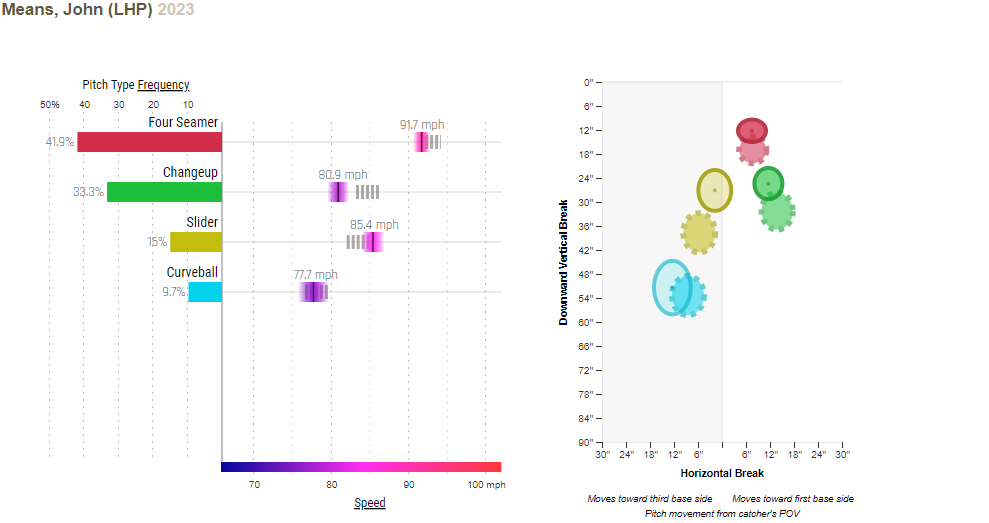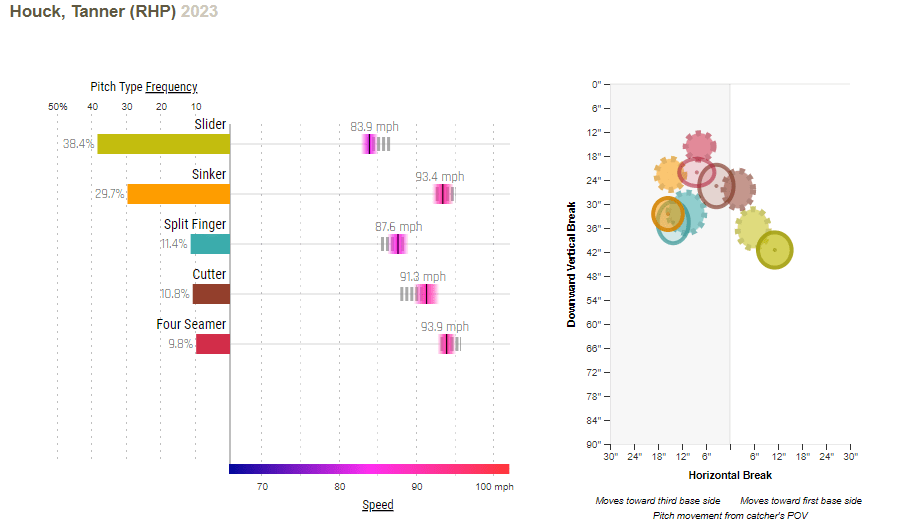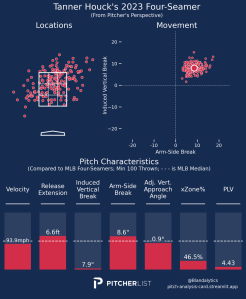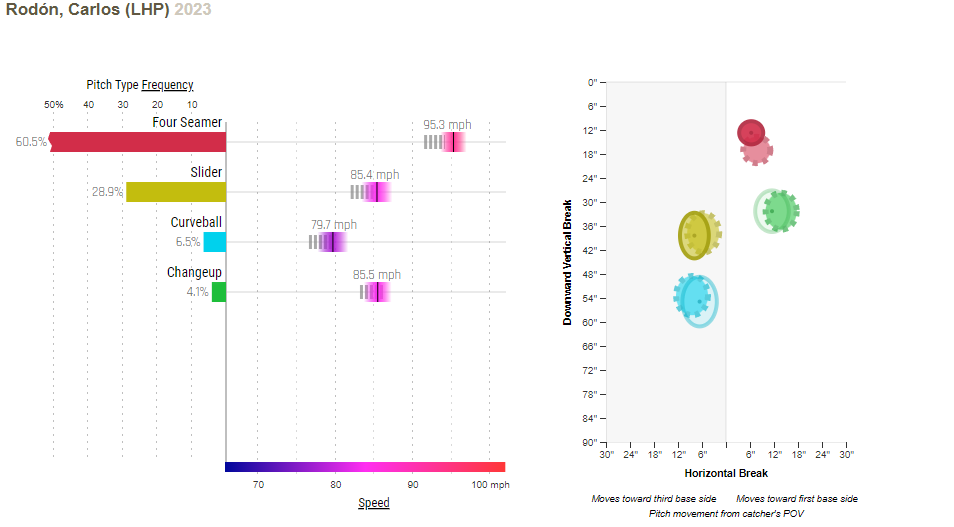The American League East was one of the best divisions in MLB history in 2023, boasting a 449-361 record (55.4% W/L), which was the third best all time by win/loss %.
Primarily, this was on the back of its elite pitching, as four out of five teams (sorry Red Sox) finished with a team ERA below 4.
However, some of the better pitchers in the AL East barely contributed to this or were even a detriment to the success the AL East saw in 2023.
Three of these pitchers were John Means, Tanner Houck, and Carlos Rodón.
Each of them struggled in varying ways, but some of the better parts of their game went wrong in 2023. With some changes to their approach, I believe these pitchers can be set for a rebound in 2024.
Means had the weirdest 2023 season of the three. Coming off a lost 2022 season, where he appeared in just two games, Means made only four major league starts in 2023.
These starts may not appear bad, as Means had a 2.66 ERA and gave the Orioles some solid innings down the stretch. However, Means had a poor 5.24 FIP, inflated by having only 10 strikeouts with four home runs in 23.2 innings.
Means has always been a high-FIP pitcher, even through his peak in 2019-2021. Still, the severe difference between ERA and FIP suggests Means still struggled to return to his peak form during his age-30 season.
Throughout 2019-2021, Means succeeded by limiting walks and hard contact, although home runs and strikeouts have always been a bit of a problem. Means had a 3.73 ERA over 345.1 innings during that stretch, with a below-average 4.65 FIP.

Data via Baseball Savant (dotted circle = league average)
Means’s unique pitch profile is a big reason why he was able to succeed despite a below-average FIP. His four-seam, averaging around 93 at his peak, has elite vertical break, preventing it from being a big liability in his arsenal due to its low velocity.
In addition to this, Means’ high vertical “rise” was quite high on all pitches, except for the curveball. This raised his fly ball rate and thus caused his home-run-per-nine rate to be quite high.
His changeup was typically his best put-away pitch and saw its highest usage yet in 2023, while his curveball dropped back to its 2019 usage after a 2021 uptick.
The biggest concern with Means’s pitches in 2023 was their velocity.
Each of Means’s offerings lost a tick or two. While it could be due to a late-season rush back to the rotation, the best chance for Means to reach his 2019/2021 heights would be to retain his already below-average velocity.
Overall, Means’s #1 priority should be staying healthy. Injuries have unfortunately taken the past few seasons from him, and while an uptick in velocity would be helpful to his success, it wouldn’t matter if injuries accompany it.
Tanner Houck is the youngest pitcher of the three mentioned, posting a 5.01 ERA and 4.43 FIP in 2023. As Houck had an encouraging start to his career from 2020-2022, where he posted a 3.02 ERA and 2.95 FIP over 146.0 innings, Houck’s regression was a surprise to many.
While playing parts of those three seasons, Houck excelled through high ground ball rates and low walks, which limited the damage of hard-hit balls. However, in 2023, these ground balls did more damage than ever, while the rare fly ball went for a home run more often than ever before.
One of Houck’s biggest problems was how ground balls hurt him. Despite a .224 xAVG, batters had a .299 BA against him. Houck’s exit velocities, whiff rate, and other stats indicative of regression in performance stayed relatively similar to 2022, where he had a 3.15 ERA in 60 innings.
Instead, the Boston Red Sox’s infield defense could be partially responsible. In 2022, the Red Sox infield combined for -13 outs above average; below average, but not horrendous. They were ranked 22nd out of 30 teams.
In 2023, the Red Sox infield combined for -50 outs above average. That’s awful. They were last in MLB, with the next-worst Phillies being worth -35. While their infield defensive talent isn’t exactly great, as shown in 2022, they can be at least closer to mediocre.
With some young players taking more prominent roles in their infield, as well as Triston Casas having a year full-time at first base under his belt, their infield should certainly improve in 2024, at least from their abysmal 2023.

Data via Baseball Savant (dotted circle = league average)
Arsenal-wise, Houck has some holes in his pitch mix. While his slider was elite, and his splitter and cutter played well in 2023, his four-seam and sinker were bad.
Houck’s sinker was decent, and while it saw a career-high usage in 2023, its performance was mediocre, allowing a 91.7 mph average exit velocity and .504 SLG.
The four-seamer was also poor and has been for quite some time. Batters had a 93.7 mph average exit velocity against it, with a .550 SLG. Its usage dropped below 10% in 2023, lower than ever before, and for good reason.

Data via Kyle Bland and PitcherList
Along with its mediocre velocity, Houck’s four-seamer has awful vertical break. Vertical break is hugely important for a four-seam to succeed, as it is crucial for generating whiffs at the top of the zone, where Houck commonly locates it.
This gave Houck’s four-seamer a PLV of 4.43, which is well below average.
To counter this, Houck introduced a cutter in 2023, which generated solid results and could continue playing a big role in Houck’s arsenal in 2024. The four-seamer should be dropped entirely from Houck’s arsenal unless a new shape is unlocked.
The best thing Houck can do in 2024 is focus on his strengths. His slider is elite, and with his solid arsenal, Houck should be able to succeed. With some positive regression by the Red Sox defense, along with a year in the rotation under his belt, Houck is well-positioned to bounce back in 2024.
Carlos Rodón is an obvious pick for a bounce-back. After an electric two-year stretch in 2021-2022 with Chicago and San Francisco, during which Rodón posted a 2.76 ERA and 2.42 FIP over 310.2 innings, Rodón had a 6.85 ERA and 5.79 FIP over 64.1 innings in his first year with New York.
Rodón got worse in nearly every aspect. His stuff, which had an elite 5.26 PLV in 2022, dropped to an average 5.06 in 2023. This resulted in his whiff rate, essential for generating strikeouts, falling drastically from 31.2% in 2022 to 26.3% in 2023.
His command got worse as well, going from a 2.5 walks-per-nine rate in 2021-2022 to 3.9 in 2023. Rodón’s mistakes within the zone got punished more frequently as well, giving him a career-high 2.1 home-run-per-nine rate after being quite solid at preventing home runs in 2021-2022.
There are many reasons this can be attributed to. One is injuries, as Rodón began the season on the IL with an arm injury, and returned once again in August with a hamstring injury.
Another could be physical and mental issues, outside of injury. Throughout 2023, Rodón had many instances of poor performance, as well as bad reactions to this performance.
Entering 2024, Rodón showed up to camp in a much better position, both mentally and physically. A good start to the year could build back Rodón’s confidence, a self-admitted important part of his game.

Data via Baseball Savant (dotted circle = league average)
Rodón has always had a unique pitch mix. He heavily relies on his four-seam/slider combo, which has had above-average movement and generated great results. These results did not continue in 2023, especially for his fastball.
Rodón’s money pitch has always been the four-seamer; he throws it a ton, and it does wonders for him. In 2021-2022, the pitch had a Run Value of 48, which is elite. In 2023, it was worth -6.
Run Value is found through a combination of results and expected results, and as it was hit much harder and for more hits than in the past, it was a below-average pitch for Rodón.
Rodón also throws a changeup and curveball around 10% of the time. While average movement-wise, it could be helpful to incorporate into his arsenal more frequently when either of his two primary pitches is off.
In addition, as pitchers get older, their stuff declines. I don’t believe this decline has begun yet for Rodón, and since he has reportedly begun spring training with his elite stuff back, this may not be a problem yet. When this takes place, however, a more developed arsenal will be hugely beneficial for his success.
Overall, Rodón enters 2024 with huge expectations, which is crazy to say after the difficult season Rodón had in ’23. With a championship in their foresight, and many other big acquisitions (including Juan Soto), the Yankees need Rodón to be a solid pitcher in their rotation.
I believe this will happen. Aside from the physical improvements, Rodón should see some positive regression from his relatively poor batted-ball luck, and a healthy spring training could set him up better to enter the regular season as the Yankees’ #2 starter.

